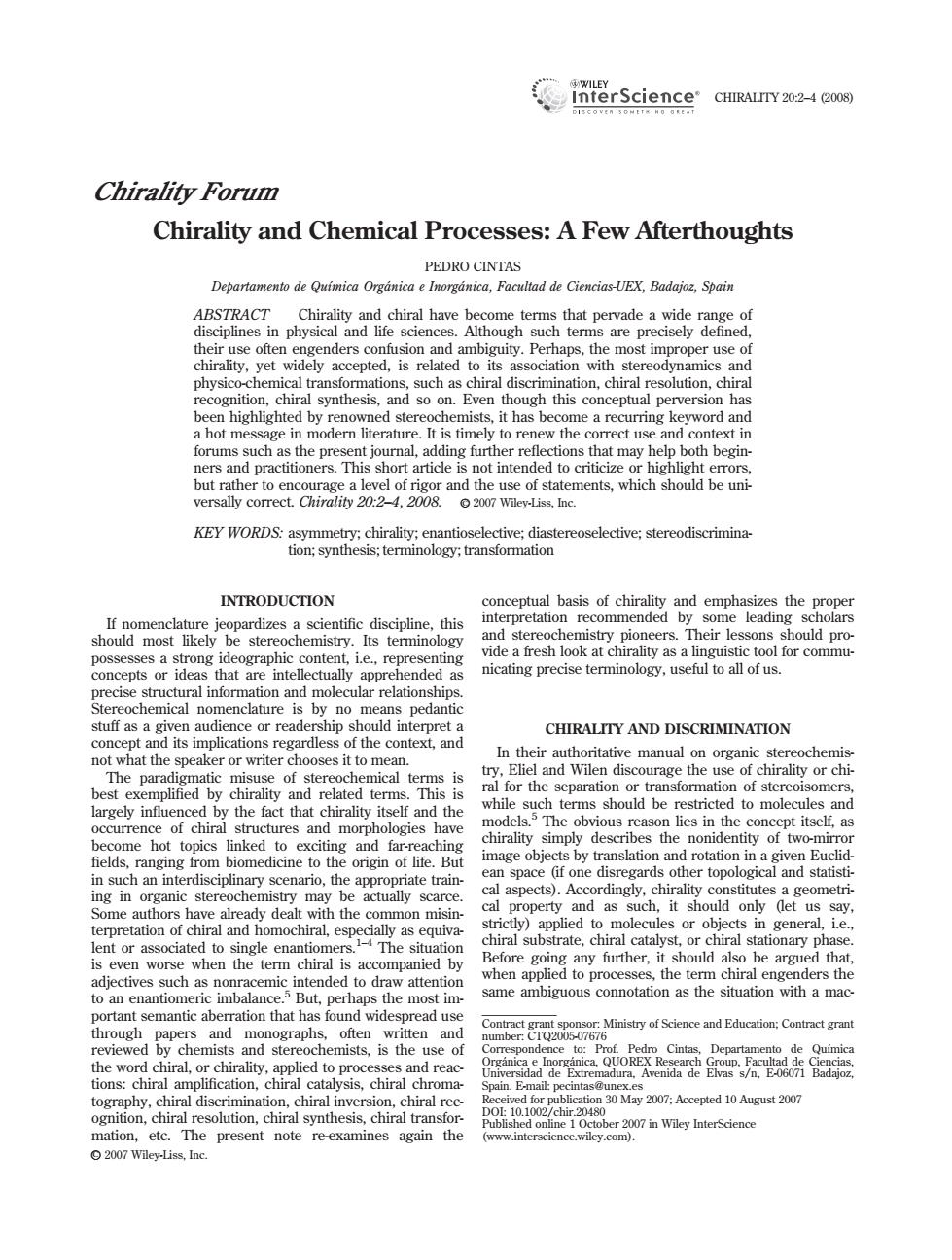正在加载图片...

iterScience CHRALTY00 Chirality Forum Chirality and Chemical Processes:A Few Afterthoughts PEDRO CINTAS Departamento de Quimica.Facultad de Ciencias-UEX.Badajoz Spain ARSTRACT and chiral have e science Although terms that p chirality.yet thesis a hot igthighledbyrenonedsteres mists,it has bec ome a recurring keyword and forums such as the pres ing urher ions nat may oth begin but rar and the use of st to crit nts,which should versally correct.Chirality20:4,2008 2007 Wiley-Liss,Inc KEY WORDS ereo tive:stereodiscrimina INTRODUCTION ceptua basis of chirality and emphasizes the prope menclatu end emistry.Its termino and ster CHIRALITY AND DISCRIMINATION In their authoritative manual on organic stereochemis and related while estricted to molecules and f life enario,the ap train image obe。 actually cal aspects).Accordingly,chirality e or ahi retation rate,chiral cata st or ven worse when the term chiral is accompanied by when ar ed to proces the term chiral eng ders th ambiguous conoation as the situation with a mac rant semantic tion that h found wides pread us 即hemists..ishe mation,etc.The present note reexamines again the 2007 Wiley-Liss.Inc Chirality Forum Chirality and Chemical Processes: A Few Afterthoughts PEDRO CINTAS Departamento de Quı´mica Orga´ nica e Inorga´ nica, Facultad de Ciencias-UEX, Badajoz, Spain ABSTRACT Chirality and chiral have become terms that pervade a wide range of disciplines in physical and life sciences. Although such terms are precisely defined, their use often engenders confusion and ambiguity. Perhaps, the most improper use of chirality, yet widely accepted, is related to its association with stereodynamics and physico-chemical transformations, such as chiral discrimination, chiral resolution, chiral recognition, chiral synthesis, and so on. Even though this conceptual perversion has been highlighted by renowned stereochemists, it has become a recurring keyword and a hot message in modern literature. It is timely to renew the correct use and context in forums such as the present journal, adding further reflections that may help both beginners and practitioners. This short article is not intended to criticize or highlight errors, but rather to encourage a level of rigor and the use of statements, which should be universally correct. Chirality 20:2–4, 2008. VC 2007 Wiley-Liss, Inc. KEY WORDS: asymmetry; chirality; enantioselective; diastereoselective; stereodiscrimination; synthesis; terminology; transformation INTRODUCTION If nomenclature jeopardizes a scientific discipline, this should most likely be stereochemistry. Its terminology possesses a strong ideographic content, i.e., representing concepts or ideas that are intellectually apprehended as precise structural information and molecular relationships. Stereochemical nomenclature is by no means pedantic stuff as a given audience or readership should interpret a concept and its implications regardless of the context, and not what the speaker or writer chooses it to mean. The paradigmatic misuse of stereochemical terms is best exemplified by chirality and related terms. This is largely influenced by the fact that chirality itself and the occurrence of chiral structures and morphologies have become hot topics linked to exciting and far-reaching fields, ranging from biomedicine to the origin of life. But in such an interdisciplinary scenario, the appropriate training in organic stereochemistry may be actually scarce. Some authors have already dealt with the common misinterpretation of chiral and homochiral, especially as equivalent or associated to single enantiomers.1–4 The situation is even worse when the term chiral is accompanied by adjectives such as nonracemic intended to draw attention to an enantiomeric imbalance.5 But, perhaps the most important semantic aberration that has found widespread use through papers and monographs, often written and reviewed by chemists and stereochemists, is the use of the word chiral, or chirality, applied to processes and reactions: chiral amplification, chiral catalysis, chiral chromatography, chiral discrimination, chiral inversion, chiral recognition, chiral resolution, chiral synthesis, chiral transformation, etc. The present note re-examines again the conceptual basis of chirality and emphasizes the proper interpretation recommended by some leading scholars and stereochemistry pioneers. Their lessons should provide a fresh look at chirality as a linguistic tool for communicating precise terminology, useful to all of us. CHIRALITY AND DISCRIMINATION In their authoritative manual on organic stereochemistry, Eliel and Wilen discourage the use of chirality or chiral for the separation or transformation of stereoisomers, while such terms should be restricted to molecules and models.5 The obvious reason lies in the concept itself, as chirality simply describes the nonidentity of two-mirror image objects by translation and rotation in a given Euclidean space (if one disregards other topological and statistical aspects). Accordingly, chirality constitutes a geometrical property and as such, it should only (let us say, strictly) applied to molecules or objects in general, i.e., chiral substrate, chiral catalyst, or chiral stationary phase. Before going any further, it should also be argued that, when applied to processes, the term chiral engenders the same ambiguous connotation as the situation with a macContract grant sponsor: Ministry of Science and Education; Contract grant number: CTQ2005-07676 Correspondence to: Prof. Pedro Cintas, Departamento de Quı´mica Orga´nica e Inorga´nica, QUOREX Research Group, Facultad de Ciencias, Universidad de Extremadura, Avenida de Elvas s/n, E-06071 Badajoz, Spain. E-mail: pecintas@unex.es Received for publication 30 May 2007; Accepted 10 August 2007 DOI: 10.1002/chir.20480 Published online 1 October 2007 in Wiley InterScience (www.interscience.wiley.com). CHIRALITY 20:2–4 (2008) VC 2007 Wiley-Liss, Inc